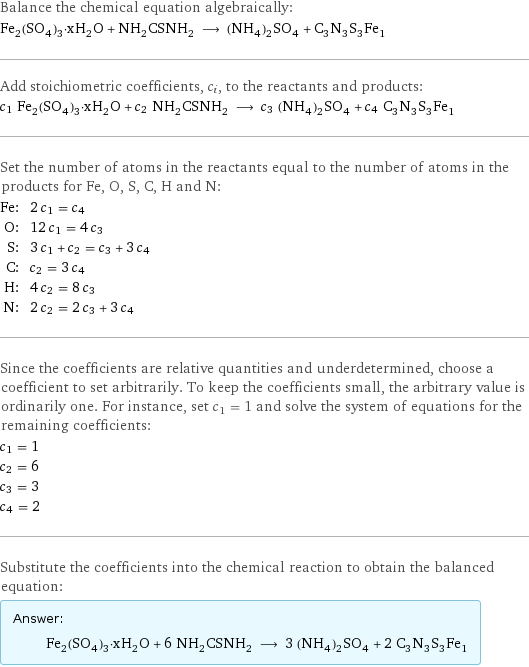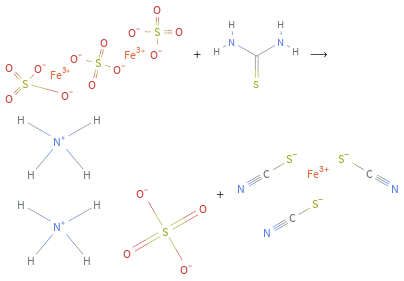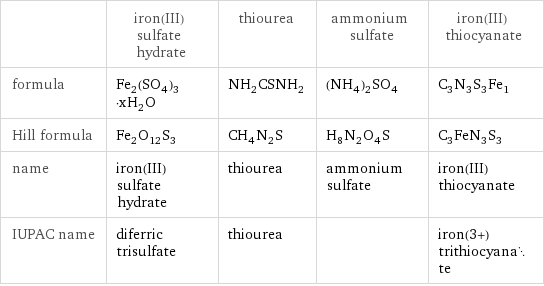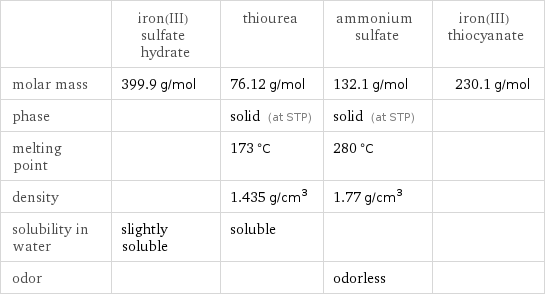Input interpretation

Fe_2(SO_4)_3·xH_2O iron(III) sulfate hydrate + NH_2CSNH_2 thiourea ⟶ (NH_4)_2SO_4 ammonium sulfate + C_3N_3S_3Fe_1 iron(III) thiocyanate
Balanced equation

Balance the chemical equation algebraically: Fe_2(SO_4)_3·xH_2O + NH_2CSNH_2 ⟶ (NH_4)_2SO_4 + C_3N_3S_3Fe_1 Add stoichiometric coefficients, c_i, to the reactants and products: c_1 Fe_2(SO_4)_3·xH_2O + c_2 NH_2CSNH_2 ⟶ c_3 (NH_4)_2SO_4 + c_4 C_3N_3S_3Fe_1 Set the number of atoms in the reactants equal to the number of atoms in the products for Fe, O, S, C, H and N: Fe: | 2 c_1 = c_4 O: | 12 c_1 = 4 c_3 S: | 3 c_1 + c_2 = c_3 + 3 c_4 C: | c_2 = 3 c_4 H: | 4 c_2 = 8 c_3 N: | 2 c_2 = 2 c_3 + 3 c_4 Since the coefficients are relative quantities and underdetermined, choose a coefficient to set arbitrarily. To keep the coefficients small, the arbitrary value is ordinarily one. For instance, set c_1 = 1 and solve the system of equations for the remaining coefficients: c_1 = 1 c_2 = 6 c_3 = 3 c_4 = 2 Substitute the coefficients into the chemical reaction to obtain the balanced equation: Answer: | | Fe_2(SO_4)_3·xH_2O + 6 NH_2CSNH_2 ⟶ 3 (NH_4)_2SO_4 + 2 C_3N_3S_3Fe_1
Structures

+ ⟶ +
Names

iron(III) sulfate hydrate + thiourea ⟶ ammonium sulfate + iron(III) thiocyanate
Equilibrium constant
![Construct the equilibrium constant, K, expression for: Fe_2(SO_4)_3·xH_2O + NH_2CSNH_2 ⟶ (NH_4)_2SO_4 + C_3N_3S_3Fe_1 Plan: • Balance the chemical equation. • Determine the stoichiometric numbers. • Assemble the activity expression for each chemical species. • Use the activity expressions to build the equilibrium constant expression. Write the balanced chemical equation: Fe_2(SO_4)_3·xH_2O + 6 NH_2CSNH_2 ⟶ 3 (NH_4)_2SO_4 + 2 C_3N_3S_3Fe_1 Assign stoichiometric numbers, ν_i, using the stoichiometric coefficients, c_i, from the balanced chemical equation in the following manner: ν_i = -c_i for reactants and ν_i = c_i for products: chemical species | c_i | ν_i Fe_2(SO_4)_3·xH_2O | 1 | -1 NH_2CSNH_2 | 6 | -6 (NH_4)_2SO_4 | 3 | 3 C_3N_3S_3Fe_1 | 2 | 2 Assemble the activity expressions accounting for the state of matter and ν_i: chemical species | c_i | ν_i | activity expression Fe_2(SO_4)_3·xH_2O | 1 | -1 | ([Fe2(SO4)3·xH2O])^(-1) NH_2CSNH_2 | 6 | -6 | ([NH2CSNH2])^(-6) (NH_4)_2SO_4 | 3 | 3 | ([(NH4)2SO4])^3 C_3N_3S_3Fe_1 | 2 | 2 | ([C3N3S3Fe1])^2 The equilibrium constant symbol in the concentration basis is: K_c Mulitply the activity expressions to arrive at the K_c expression: Answer: | | K_c = ([Fe2(SO4)3·xH2O])^(-1) ([NH2CSNH2])^(-6) ([(NH4)2SO4])^3 ([C3N3S3Fe1])^2 = (([(NH4)2SO4])^3 ([C3N3S3Fe1])^2)/([Fe2(SO4)3·xH2O] ([NH2CSNH2])^6)](../image_source/c3790fc77d9a227605322dc746a17959.png)
Construct the equilibrium constant, K, expression for: Fe_2(SO_4)_3·xH_2O + NH_2CSNH_2 ⟶ (NH_4)_2SO_4 + C_3N_3S_3Fe_1 Plan: • Balance the chemical equation. • Determine the stoichiometric numbers. • Assemble the activity expression for each chemical species. • Use the activity expressions to build the equilibrium constant expression. Write the balanced chemical equation: Fe_2(SO_4)_3·xH_2O + 6 NH_2CSNH_2 ⟶ 3 (NH_4)_2SO_4 + 2 C_3N_3S_3Fe_1 Assign stoichiometric numbers, ν_i, using the stoichiometric coefficients, c_i, from the balanced chemical equation in the following manner: ν_i = -c_i for reactants and ν_i = c_i for products: chemical species | c_i | ν_i Fe_2(SO_4)_3·xH_2O | 1 | -1 NH_2CSNH_2 | 6 | -6 (NH_4)_2SO_4 | 3 | 3 C_3N_3S_3Fe_1 | 2 | 2 Assemble the activity expressions accounting for the state of matter and ν_i: chemical species | c_i | ν_i | activity expression Fe_2(SO_4)_3·xH_2O | 1 | -1 | ([Fe2(SO4)3·xH2O])^(-1) NH_2CSNH_2 | 6 | -6 | ([NH2CSNH2])^(-6) (NH_4)_2SO_4 | 3 | 3 | ([(NH4)2SO4])^3 C_3N_3S_3Fe_1 | 2 | 2 | ([C3N3S3Fe1])^2 The equilibrium constant symbol in the concentration basis is: K_c Mulitply the activity expressions to arrive at the K_c expression: Answer: | | K_c = ([Fe2(SO4)3·xH2O])^(-1) ([NH2CSNH2])^(-6) ([(NH4)2SO4])^3 ([C3N3S3Fe1])^2 = (([(NH4)2SO4])^3 ([C3N3S3Fe1])^2)/([Fe2(SO4)3·xH2O] ([NH2CSNH2])^6)
Rate of reaction
![Construct the rate of reaction expression for: Fe_2(SO_4)_3·xH_2O + NH_2CSNH_2 ⟶ (NH_4)_2SO_4 + C_3N_3S_3Fe_1 Plan: • Balance the chemical equation. • Determine the stoichiometric numbers. • Assemble the rate term for each chemical species. • Write the rate of reaction expression. Write the balanced chemical equation: Fe_2(SO_4)_3·xH_2O + 6 NH_2CSNH_2 ⟶ 3 (NH_4)_2SO_4 + 2 C_3N_3S_3Fe_1 Assign stoichiometric numbers, ν_i, using the stoichiometric coefficients, c_i, from the balanced chemical equation in the following manner: ν_i = -c_i for reactants and ν_i = c_i for products: chemical species | c_i | ν_i Fe_2(SO_4)_3·xH_2O | 1 | -1 NH_2CSNH_2 | 6 | -6 (NH_4)_2SO_4 | 3 | 3 C_3N_3S_3Fe_1 | 2 | 2 The rate term for each chemical species, B_i, is 1/ν_i(Δ[B_i])/(Δt) where [B_i] is the amount concentration and t is time: chemical species | c_i | ν_i | rate term Fe_2(SO_4)_3·xH_2O | 1 | -1 | -(Δ[Fe2(SO4)3·xH2O])/(Δt) NH_2CSNH_2 | 6 | -6 | -1/6 (Δ[NH2CSNH2])/(Δt) (NH_4)_2SO_4 | 3 | 3 | 1/3 (Δ[(NH4)2SO4])/(Δt) C_3N_3S_3Fe_1 | 2 | 2 | 1/2 (Δ[C3N3S3Fe1])/(Δt) (for infinitesimal rate of change, replace Δ with d) Set the rate terms equal to each other to arrive at the rate expression: Answer: | | rate = -(Δ[Fe2(SO4)3·xH2O])/(Δt) = -1/6 (Δ[NH2CSNH2])/(Δt) = 1/3 (Δ[(NH4)2SO4])/(Δt) = 1/2 (Δ[C3N3S3Fe1])/(Δt) (assuming constant volume and no accumulation of intermediates or side products)](../image_source/2b28e3afc658aff87562ccd272b216fb.png)
Construct the rate of reaction expression for: Fe_2(SO_4)_3·xH_2O + NH_2CSNH_2 ⟶ (NH_4)_2SO_4 + C_3N_3S_3Fe_1 Plan: • Balance the chemical equation. • Determine the stoichiometric numbers. • Assemble the rate term for each chemical species. • Write the rate of reaction expression. Write the balanced chemical equation: Fe_2(SO_4)_3·xH_2O + 6 NH_2CSNH_2 ⟶ 3 (NH_4)_2SO_4 + 2 C_3N_3S_3Fe_1 Assign stoichiometric numbers, ν_i, using the stoichiometric coefficients, c_i, from the balanced chemical equation in the following manner: ν_i = -c_i for reactants and ν_i = c_i for products: chemical species | c_i | ν_i Fe_2(SO_4)_3·xH_2O | 1 | -1 NH_2CSNH_2 | 6 | -6 (NH_4)_2SO_4 | 3 | 3 C_3N_3S_3Fe_1 | 2 | 2 The rate term for each chemical species, B_i, is 1/ν_i(Δ[B_i])/(Δt) where [B_i] is the amount concentration and t is time: chemical species | c_i | ν_i | rate term Fe_2(SO_4)_3·xH_2O | 1 | -1 | -(Δ[Fe2(SO4)3·xH2O])/(Δt) NH_2CSNH_2 | 6 | -6 | -1/6 (Δ[NH2CSNH2])/(Δt) (NH_4)_2SO_4 | 3 | 3 | 1/3 (Δ[(NH4)2SO4])/(Δt) C_3N_3S_3Fe_1 | 2 | 2 | 1/2 (Δ[C3N3S3Fe1])/(Δt) (for infinitesimal rate of change, replace Δ with d) Set the rate terms equal to each other to arrive at the rate expression: Answer: | | rate = -(Δ[Fe2(SO4)3·xH2O])/(Δt) = -1/6 (Δ[NH2CSNH2])/(Δt) = 1/3 (Δ[(NH4)2SO4])/(Δt) = 1/2 (Δ[C3N3S3Fe1])/(Δt) (assuming constant volume and no accumulation of intermediates or side products)
Chemical names and formulas

| iron(III) sulfate hydrate | thiourea | ammonium sulfate | iron(III) thiocyanate formula | Fe_2(SO_4)_3·xH_2O | NH_2CSNH_2 | (NH_4)_2SO_4 | C_3N_3S_3Fe_1 Hill formula | Fe_2O_12S_3 | CH_4N_2S | H_8N_2O_4S | C_3FeN_3S_3 name | iron(III) sulfate hydrate | thiourea | ammonium sulfate | iron(III) thiocyanate IUPAC name | diferric trisulfate | thiourea | | iron(3+) trithiocyanate
Substance properties

| iron(III) sulfate hydrate | thiourea | ammonium sulfate | iron(III) thiocyanate molar mass | 399.9 g/mol | 76.12 g/mol | 132.1 g/mol | 230.1 g/mol phase | | solid (at STP) | solid (at STP) | melting point | | 173 °C | 280 °C | density | | 1.435 g/cm^3 | 1.77 g/cm^3 | solubility in water | slightly soluble | soluble | | odor | | | odorless |
Units
